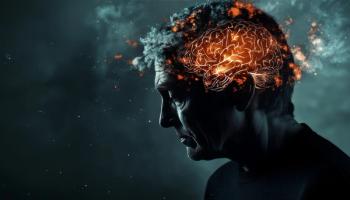
- Vol 41, Issue 3
Chemotherapy-Induced Psychosis in an Adolescent
Check out this case study to learn more about how viral infections might play a role in triggering psychotic disorders.
CASE REPORT
"Mr Devon” is a Black young man, aged 16 years, with past psychiatric history of autism spectrum disorder and oppositional defiant disorder. He has a past medical history of recently diagnosed nasopharyngeal carcinoma with metastatic disease to the left cervical lymph node (Tis, N2b, M0, stage IVA per National Comprehensive Cancer Network and T1, N1, M0, stage IIB per American Joint Committee on Cancer staging). Mr Devon recently developed religious delusions, command auditory hallucinations, thoughts of auto-enucleation and coprophagia, and disorganizations of speech and behavior during chemotherapy with cisplatin and 5-fluorouracil.
Oncology Medical History
Briefly, Mr Devon received a diagnosis of stage IIA nasopharyngeal carcinoma of the posterior nasopharynx with a 5.3-cm left lymph nodal mass and was aggressively treated according to ARAR0331 (NCT00274937) protocol (in approximate doses of cisplatin 80 mg/m2 and 5-fluorouracil 1000 mg/m2 as the combined chemotherapy agents for each cycle). He tolerated cycle 1 well with mild nausea and fatigue, underwent an excision of the growing left neck lymph node in June, then completed chemotherapy induction cycle 2 about 10 days later and was deemed medically stable for discharge.
Psychiatric Interventions
Mr Devon was absent for cycle 3 chemotherapy induction in early July; he eloped from his home during the time of the scheduled appointment and was observed by a neighbor to be walking in his neighborhood barefoot in sweltering heat of over 100 °F, not responding when his name was called. The police were called for a welfare check and he was brought to the emergency department (ED) for further evaluation, where he interfaced with the pediatric psychiatry consult service for the first time.
On examination, he was observed to be internally preoccupied, disoriented to date and situation, withdrawn with flat affect, and exhibiting thought latency—an acute change from his baseline mental status. Although normally a bright and thoughtful young man, Mr Devon did not know which school he attended, which grade he was in, or the date. He was scanning the room suspiciously. When asked, he confirmed that he was hearing voices of “God” telling him to refuse further cancer treatment and to no longer listen to the treating physicians.
His family had noticed an acute change in his behavior approximately 2 weeks before his presentation to the ED, including disruption in sleep, bizarre behavior of standing in place and staring, and talking of resisting treatment. His family history is notable for
Mr Devon was admitted to the floor and further diagnostic tests were conducted, revealing no acute intracranial findings on a CT of the head, but an ultrasound identified an irregular fluid collection in the neck with an accompanying lymph node. He was started on aripiprazole 10 mg daily for psychosis and
Mr Devon’s psychiatric condition continued to disrupt the progression of his medical treatment. The auditory hallucinations were telling him to eat his own feces as a form of religious punishment. He also was preoccupied with removing his right eye as it had “caused him to sin.” He remained fixated on reading Old Testament passages of the Bible. The voices began to “speak through” him, and he would change his tone of voice to match the voices that he heard. He would consult with hallucinated individuals in the room: “I can make them astral project.”
Mr Devon would hold himself in strange, fixed positions on the hospital bed; for example, standing for several minutes on a single foot while gazing at the wall. For 3 days in a row, he also tried to force his way into the food and nutrition room so that he could find a plastic spoon to “gouge my sinful eyes out.” If the water faucet turned on or if something appeared on the TV screen, Mr Devon would say, “He did that. He is announcing his presence.” Mr Devon required a 1:1 sitter to always be in place, sometimes a security officer, and he was only allowed to eat with paper utensils on a safe tray.
Mr Devon eventually completed his last cycle of chemotherapy, cycle 3, on July 16, 2023, while admitted to the floor. He received 80 mg/m2 of cisplatin on day 1 and 1000 mg/m2 of 5-fluorouracil on days 1 to 5. Oral haloperidol was increased to 10 mg twice a day with complications of dystonia managed by oral diphenhydramine and benztropine. We attempted placement at several inpatient psychiatric facilities, all of which refused him because of medical complexity and having a G-button in place. A positive response to chemotherapy emerged from the MRI assessment a week later, reinforcing discussions about radiation treatment. During this period, the management of elevated creatinine levels led to consultation with nephrology, alongside reiterated plans for 25 cycles of radiation treatment that required hospital admission.
Due to the severity of the psychosis that seemed to develop during chemotherapy treatment, neurology was consulted for further evaluation. A lumbar puncture was scheduled to assess cerebrospinal fluid for encephalopathy and autoimmune/paraneoplastic etiologies. Continuous video electroencephalogram monitoring yielded normal results, ruling out the presence of epileptic activity. Cerebrospinal fluid studies showed no definitive markers of autoimmune encephalitis, thereby discounting initial suspicions of an autoimmune etiology underlying his psychiatric symptoms. MRI of the brain revealed no significant intracranial abnormality.
Due to persistent dystonia and lack of efficacy on 20 mg haloperidol daily for 2 weeks, risperidone 0.5 mg twice a day was initiated and oral haloperidol was halted due to continued dystonia. Shortly thereafter, risperidone was increased to 1 mg once a day in the morning and 2 mg 4 times daily for psychosis management. Oral valproate at 500 mg twice daily was also trialed to assist with management of agitation; however, he developed ataxia and worsening sedation. Despite this treatment protocol, he continued to be internally preoccupied and had increasing episodes of reported agitation and acute worsening of mental status. He frequently threatened to kill staff, sometimes via “divine intervention and wrath.” The decision was finally made to discontinue risperidone and valproate and begin treatment with clozapine and lithium due to the severity of his psychosis, preoccupation with self-harm, and his preponderance toward extrapyramidal adverse effects. Lithium was initiated to assist with mood, agitation, and to help bolster his absolute neutrophil count, which fluctuated from a normal range to less than 1500 with each radiation treatment.
As all local facilities continued to reject Mr Devon due to his medical complications and need for radiation therapy for treatment of the malignancy, our psychiatry consult service continued to evaluate and treat the patient while admitted to the floor during the following 6 weeks. Clozapine was increased to 50 mg twice daily, lithium to 600 mg at bedtime with serum blood level of 0.8, and aripiprazole was restarted and increased to 15 mg daily. His mood improved and his agitation and the extrapyramidal symptoms resolved. He continued to endorse auditory hallucinations and would vacillate between talking in the first person and the third person, but his outward delusional thought content of religious persecution and beliefs that he needed to harm himself and refuse treatment of his malignancy finally ceased. It was determined that the patient, while nearing the end of his cancer treatment, would need continued treatment at an inpatient facility or potentially state hospitalization once his medical contraindications resolved.
Discussion
The patient’s case is particularly noteworthy due to the convergence of multiple factors: his medical history of Epstein-Barr virus–positive (EBV+) nasopharyngeal carcinoma with metastatic disease, his psychiatric history of autism and oppositional defiant disorder, and his family’s strong psychiatric history. The patient’s acute-onset psychosis in the context of his medical illness and potential neurotoxicity from chemotherapy raises several important considerations. First, the interaction between his malignancy and treatment—specifically EBV+ malignancy, cisplatin, and 5-fluorouracil—and his psychosis is rare and complex. Second, the patient’s family psychiatric history, including first-degree relatives with legitimate bipolar disorder and schizophrenia, suggests a genetic predisposition for psychiatric disorders. Third, although his presentation exuded prodromal symptoms of schizophrenia, he clearly developed these symptoms during his chemotherapy course, as noted by his abrupt change in mental status by observant parents. This case also highlights the challenges of treating psychotic disorders in the setting of existing malignancy necessitating chemotherapy and radiation treatment. Although the patient finally exhibited a substantial treatment response to
Existing literature offers some parallels to this case. Notably, instances of chemotherapy-induced acute psychosis have been documented in germ cell tumor patients, as seen in a 2015 study about a woman aged 25 years showing acute psychosis post chemotherapy.1 A similar case was presented in 2011 discussing an adolescent with a testicular germ cell tumor.2 Although many patients with cancer experience depression and anxiety, only a few develop psychotic symptoms. For example, a study by Harter et al found that just 10 of 517 adult patients with cancer manifested psychotic disorders.3 Pediatric cancer–associated psychosis cases are even rarer, mostly related to central nervous system malignancies or leukemia.4 Intriguingly, the literature does not extensively correlate EBV nasopharyngeal carcinoma with psychosis, and despite cisplatin’s neurotoxic properties, no direct links to psychiatric complications have been established.
The potential etiological influence of viral infections, particularly herpes simplex and EBV, on the emergence of psychotic symptoms has been highlighted in several scientific investigations. For example, a case report in 2017 discussed a psychotic disorder that emerged after the reactivation of a herpes simplex infection, set against the background of mannose-binding lecithin deficiency, a history of childhood EBV infection, and intense psychosocial stress.5
The hypothesis that viral infections might play a role in triggering psychotic disorders is not new. Menninger, as early as 1926, postulated that influenza viral infections could potentially be a causative factor in schizophrenia.6 Subsequent reports have also indicated associations between psychotic disorders and infections like EBV and herpes simplex. Another study provided further depth by investigating the correlation between antibodies to infectious agents and the subclinical positive symptoms of psychosis in adolescents, aged around an average of 16 years, from the general populace.7 Their findings suggest a significant association between serological reactions to EBV and male adolescents; however, this connection was not observed in females. This research stands out as it is among the first to delve into the serological evidence of infections with human herpes viruses and their relationship to the subclinical positive dimension of psychosis in a healthy adolescent cohort.
Ms Young is a fourth-year medical student at Texas A&M Health Science Center College of Medicine located in Bryan College Station. Dr Hodges is a PGY-4 child and adolescent fellow at Baylor Scott & White Medical Center—Temple, Texas. Dr Ansari is a child and adolescent psychiatrist at Baylor Scott & White Medical Center—Temple, Texas.
References
1. Puangthong U, Pongpirul K.
2. Campbell BA, Panicker J.
3. Härter M, Reuter K, Aschenbrenner A, et al.
4. Ducore JM, Waller DA, Emslie G, Bertolone SJ.
5. Asogwa K, Buabeng K, Kaur A.
6. Menninger KA.
7. Wang H, Yolken RH, Hoekstra PJ, et al.
Articles in this issue
over 1 year ago
Neuromodulation Approaches to Depressive Disordersover 1 year ago
Augmentation Strategies for Treatment-Resistant Depressionover 1 year ago
Attuned to the Needs of Patientsalmost 2 years ago
Good Fathersalmost 2 years ago
Mild Cognitive Impairment and Serotonin System Degenerationalmost 2 years ago
5 Processes for Focus and Empowerment in Patients With PTSDalmost 2 years ago
AI in Psychiatry: Changing the Landscape of Mental Health Carealmost 2 years ago
Advancing PsychiatryNewsletter
Receive trusted psychiatric news, expert analysis, and clinical insights — subscribe today to support your practice and your patients.














